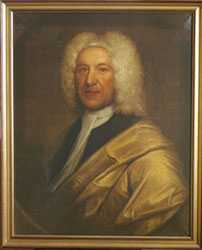Thomas Twining (merchant)

Thomas Twining (1675, Painswick, Gloucestershire, England – 19 May 1741, Twickenham, Greater London) was an English merchant, and the founder of Twinings of London.
Life
The son of a fuller who moved to London when the boy was nine years old, Thomas was at first apprenticed to a weaver. He changed careers, however, and worked for a merchant and importer. He became a Freeman of the City of London in 1701, and was working for the East India Company merchant Thomas D'Aeth. In 1706 he bought Tom's Coffee House at 216 Strand, London from D'Aeth. In addition to coffee, Twining also sold tea, and soon got a reputation for having the some of the finest blends in London. Soon he was selling more dry tea than brewed.
He expanded his store in 1717 to encompass three adjacent houses. By 1734, Twining focused almost exclusively on tea, having given up coffee. In about 1722 he bought a property later known as Dial House, next door to St Mary's Church, Twickenham, where he either rebuilt or converted and extended the buildings already there. The sundial on the façade carries the date 1726, possibly the time when the new building was finished.
Thomas Twining died in 1741 and was buried at St Mary's church, where there is a memorial to him at the north-east corner.[1]
Legacy
His son Daniel Twining took over the business. Dial House remained in the family for many years after his death and the last member of the family to live there was Elizabeth Twining, who took up residence there in 1866, after the death of her mother, and remained there until her death in 1889, whereupon the house was given to the parish of Twickenham by her brother Richard Twining (III) as a replacement for the existing vicarage, which was in a severe state of disrepair. Dial House still belongs to the Church of England and is now used as the official residence and office of the Bishop of Kensington.[2]